|
Airfix 1/48 scale
Buccaneer S.Mk.2B
"Sky Pirate"
by Ingo Degenhardt
|
 |
|
Blackburn Buccaneer S.Mk.2B |
images
by Lutz Degenhardt

HyperScale is proudly supported by Squadron
Developed by the Blackburn Company (later Hawker Siddeley) the
Buccaneer Prototype NA39 first flew on 30 April, 1958. The aircraft was
designed as a strike aircraft for the Royal Navy to be based on aircraft
carriers and entered service as the S.2 in 1965.
In the late 1960s the RAF too chose the Buccaneer for service as a
low-level strike bomber, receiving 62 ex-Royal Navy aircraft (S.2A) and
51 new-build planes (S.2B). The RAF career of the Buccaneer started in
July 1970.
After the last aircraft carriers able to operate the Buccaneer had been
decommissioned in the early 1970s, only the RAF-Buccaneers were left –
equipping Squadrons in UK and Germany.
By the late 1980s, only Nos. 12 and 208 Squadrons were still
operational at RAF Lossiemouth in the maritime strike role and No.237
OCU (Operational Conversion Unit) was responsible to provide aircrew
training.
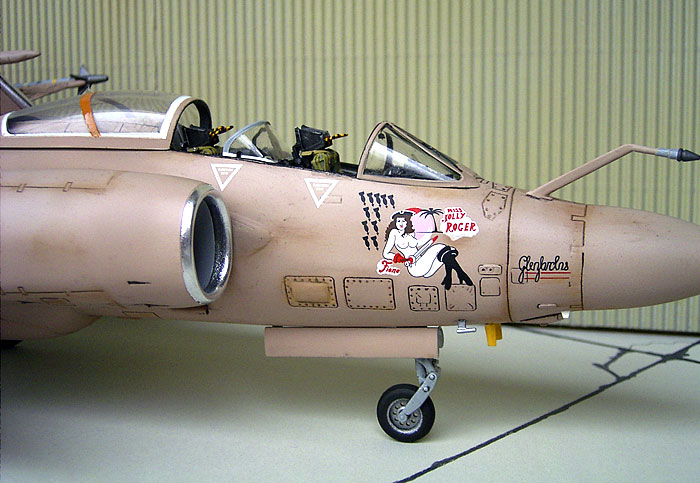
Except may be for the South African (sole export customer) Buccaneers
the RN and RAF Buccs had seen no combat so far. This changed late in
their career with the Royal Air Force when in 1991 14 aircraft were
rapidly prepared for the Operation Granby – the deployment of UK forces
for the retaking of Kuwait. 12 of the aircraft were send to Bahrain, all
painted in ARTF (Alkali Removable Temporary Finish) Desert Pink over
their standard camouflage.
With the beginning of Desert Storm it was the Buccaneers purpose to
provide ‘Pave Spike’ laser designation for RAF Tornado GR.Mk 1s laser
guided bombs. The Buccaneers flew a total of 226 sorties in their guise
as the ‘Sky Pirates’, most of them sporting a Jolly Roger flag on the
left fuselage side under the windshield.
In 1994 the last Buccaneers were taken out of RAF-service. I believe
South Africa still operates them and even offers rides in the backseat
for civilians; but I am not sure about it.
Although the Airfix 1/48 scale English Electric Lightning that I
built some time before a joy to make; the Buccaneer was not.
In particular, the fit of most parts is very poor and the whole model
needs a lot of filling, sanding and rescribing. The joints of the upper
and lower fuselage halves (do not forget to add some weight into the
nose), the air intakes, the exhaust area and the wings are the biggest
problem areas. Furthermore, some parts were warped and the overall
surface of the model had a very rough texture that had to sanded smooth.
Fortunately in this case, the engraved panel lines are very deep and do
not suffer at all from the sanding. An advantage also at all the seams
with their filling and sanding. The lines were often still visible after
that and could be used for the rescribing.
But before all this labour I had the pleasure of building and
painting the Neomega cockpit I had bought for this model. You only have
to pay some attention (i.e. dry-fitting) to the ejection seats that
refused to fit in properly between the side consoles. I discovered that
when I tried to attach them – nearly the last parts to be added to the
otherwise finished model.
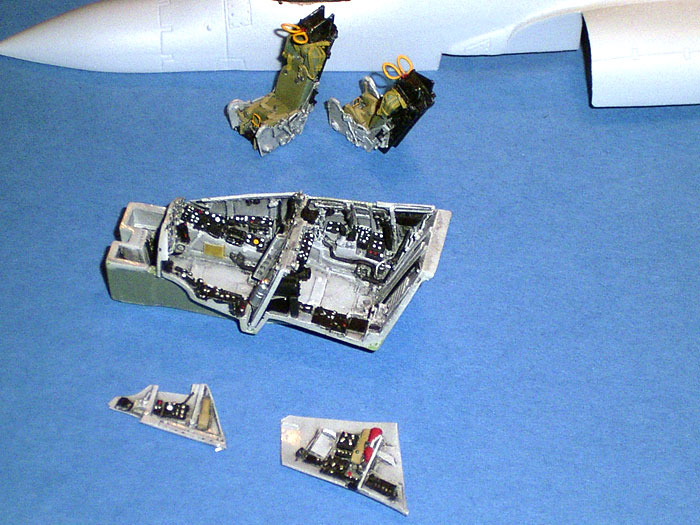
I also had Airwaves etched parts for the airbrake that included a few
other items for the exterior, definitely improving the look of the open
brakes. Another etched-metal parts set by Airwaves used on this
Buccaneer is the wing fold set – needless to say it is much superior to
the wing fold mechanism provided in the kit.
There is something wrong with the main wheels too. According to the
instructions, the brakes are on the inside while on the real thing they
are on the outside. But this problem is easily solved by simply swapping
the main mounts.
It took some time before I had this model ready for painting – with the
wings not yet attached.
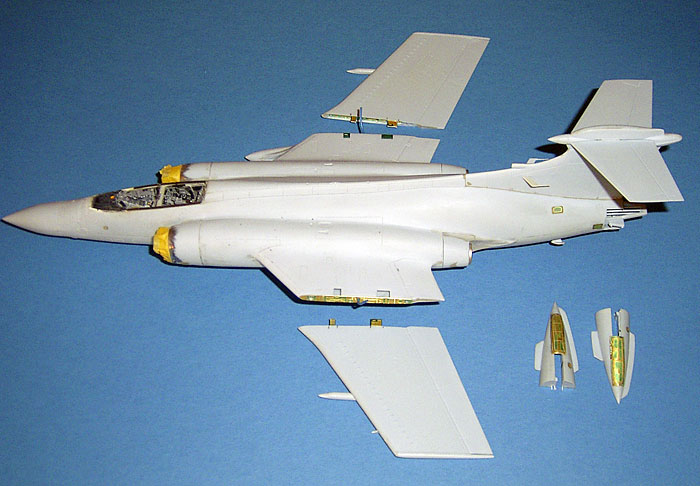
After the first base coat of flat white I discovered numeral areas
that still needed reworking, but finally it was time for Xtra-Colors X32
Desert Pink (gloss).
Paint
The leading edges of air intakes, wings and horizontal stabilators
are left in natural metal. I started with these giving the respective
areas a base coat of Humbrol gloss black and then painting them in
Alclad II’s Chrome. Carefully masking these areas was followed by an
overall coat of Desert Pink – slightly lightened up. Patches and cloudy
patterns of the original paint were sprayed at random and along the
panel lines.
Thoroughly dry, the complete aircraft received a wash with heavily
diluted flat dark brown.
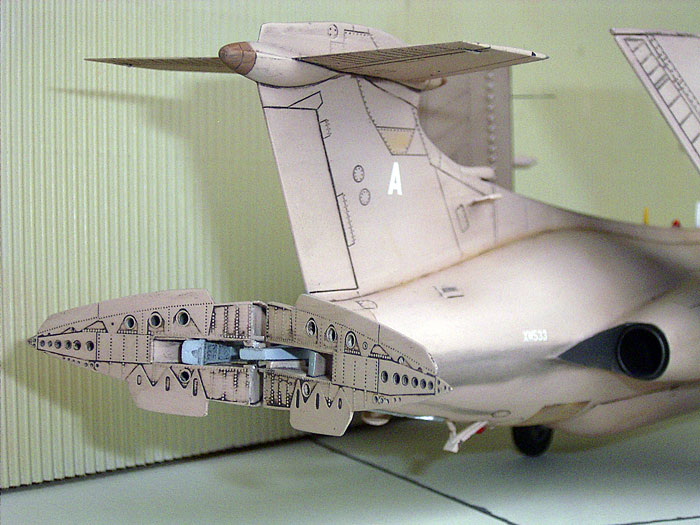
With the wash wiped off there was the perfect surface for the next
step – the decals.
Decals
The Airfix kit includes marking options for two aircraft in a
grey/green wraparound-scheme belonging to Nos. 12 and 208 Squadron at
Lossiemouth.
The third aircraft is a “Sky Pirate”, but unfortunately one of the
less colorful decorated planes. I had Model Alliance Decals No. 48-100
for the model – containing markings for 13 different aircraft. The worst
thing about these decals is encountered even before you start using them
– to choose an aircraft. I had the sheet all the time during
construction of the model (quite some time) but could not make a
definite decision. It was finally made when the decals were due.
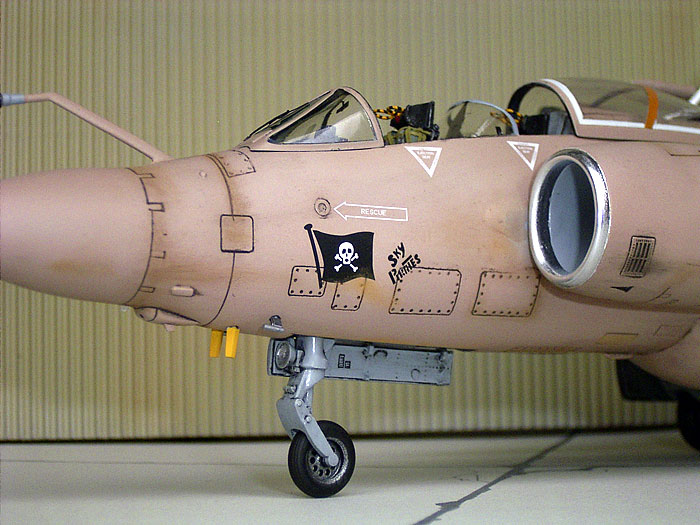
So my Buccaneer is “Miss Jolly Roger” and “Fiona” and “Glenfarclas” –
XW533 tail code ‘A’. The next bad thing with the decals is that there
are only so very few to use on this paint scheme – they go down very
well and are really fun to work with. Most of the sheet remains unused,
but there is a certain institution in the www, were I might find someone
interested in the rest of the sheet and the instructions.
The Airfix Buccaneer is a tough adversary, one you need some skills and
a good amount of self-confidence and fortitude to overcome it’s fierce
resistance to being build properly. But, as so often when finished, it
is considered being worth all the trouble and hardship – not just
because it is the only 1/48 Buccaneer that there is, but also because
the builder is satisfied with the result.
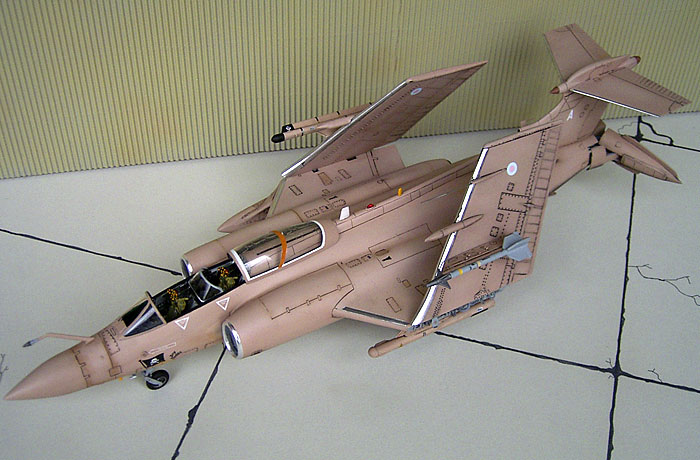
The unusual paint scheme does the rest...even though a Grey/green
camouflaged Bucc would be a nice contrast. No, not me...
Click the thumbnails below to view larger
images:
Model and Text Copyright © 2005 by
Ingo Degenhardt
Images Copyright © 2005 by Lutz Degenhardt
Page Created 17 January, 2005
Last Updated
17 January, 2005
Back to
HyperScale Main Page
|
Home
| What's New |
Features |
Gallery |
Reviews |
Reference |
Forum |
Search